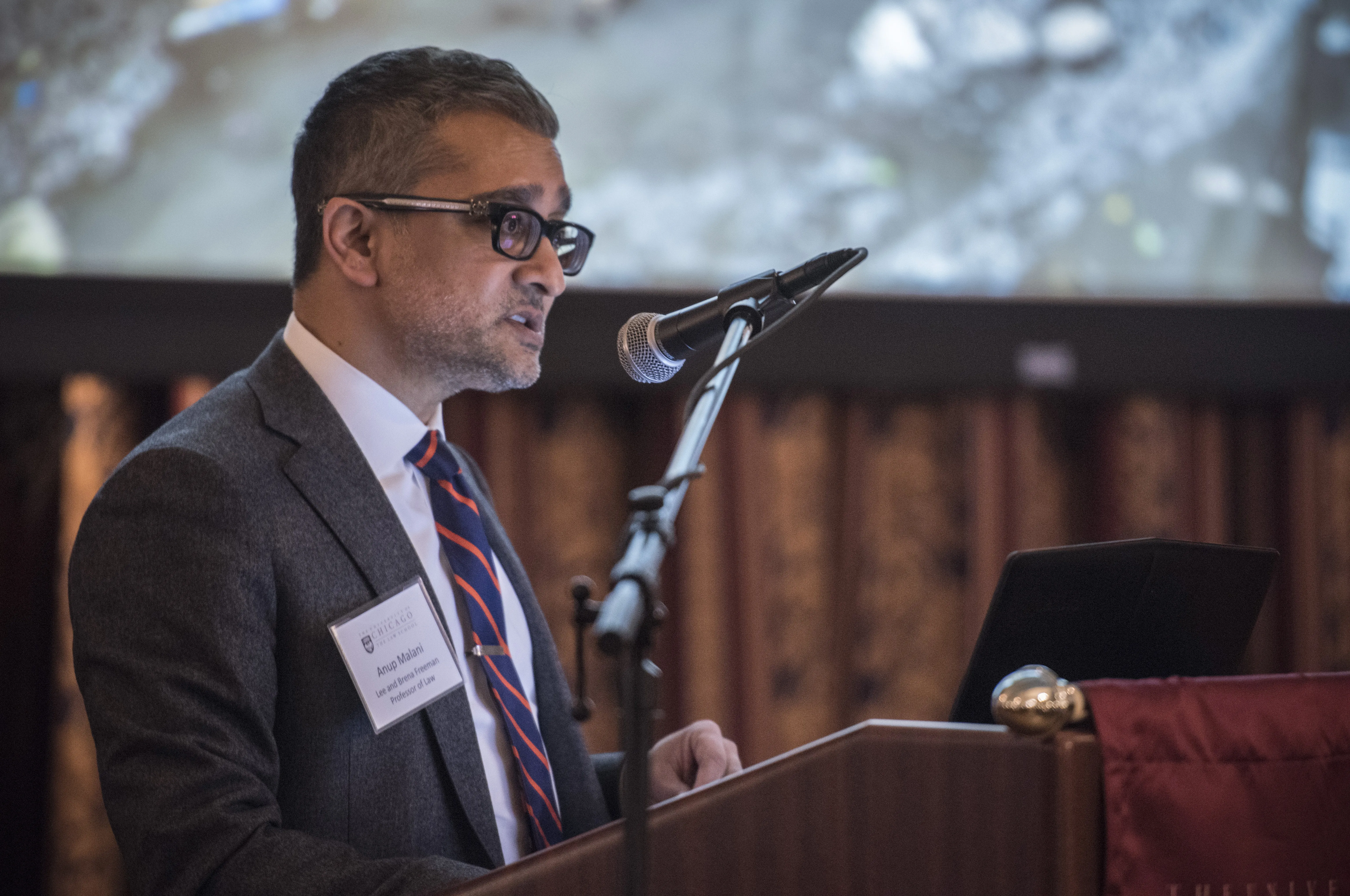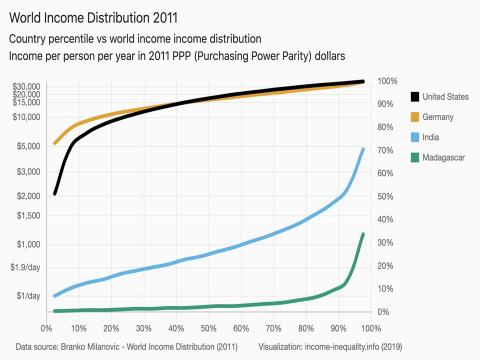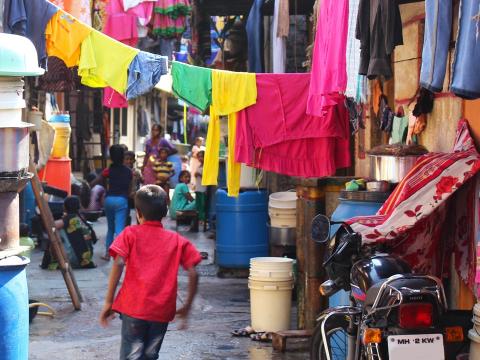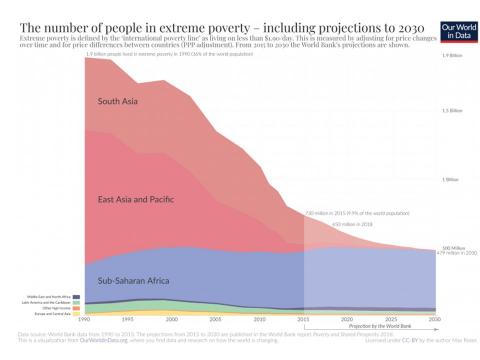Crossing the Midway to Study India's Slums

The Midway Dinner has a long tradition at the Law School. Its location is symbolic. We hold it in Ida Noyes Hall, to nudge you to explore other departments at the University, most of which are across the Midway, on this side of campus. At a place like Stanford or Duke, it would not be hard to get you to wander around campus and meet people from other departments. The sun actually comes out during the winters there. But in a place as cold as Chicago, getting you to cross the Midway requires a nudge. And sometimes, even a shove.
Despite the hurdle posed by our weather, Chicago has a great tradition of looking at problems through the lenses of different disciplines. For example, Dean Miles and I both started as graduate students in Economics together on this side of the Midway. After our coursework, we tried on a new lens and studied law. I did it at the Law School, same as you. Dean Miles did so at the University of Chicago of the East. Errr, sorry, I meant Harvard.
In the end, though, we both ended up back in Hyde Park. Perhaps it says something about our personalities. After all, University of Chicago is famously known as the place where fun comes to die. You may not believe me, but I don’t think that is the reason we came back.
I think Dean Miles and I came back to the University of Chicago because it is the one school that places no bounds on your curiosity. We both studied under the late Gary Becker, the Nobel Prize-winning economist, who taught us that there was no topic to which we could not apply economics. Becker himself started by studying race discrimination, then turned to the economics of crime, then turned to studying whom people married and why people had children. He explored the economic behavior of non-human animals, political corruption, and even the rationality of people addicted to alcohol or tobacco.
The only constraint that Becker imposed on our curiosity was to think seriously. Never take the easy approach and assume something is irrational. Make sure you understand why the world is as it is before you recommend how to change it. If you don’t, you might end up with unintended consequences.
I took this advice very seriously. Over the years I have studied habeas corpus, placebo effects, statutory interpretation, the tax status of nonprofit firms, medical malpractice, how the SARS epidemic spread, and the economics of medical research. In recent years, however, as the attention of more and more in academia has shifted toward understanding inequality, my attention naturally gravitated toward the problem of poverty.
I want to show you a perspective on poverty that really changed how I think about the topic. Here you have the income distribution of different countries plotted on a common graph. You have percentiles of the population on the horizontal axis and income on the vertical axis. The graph clearly depicts significant inequality in the US. But it also makes clear that the very poorest American makes more than 90 percent of all Indians. And more than nearly every person in Madagascar. Clearly, if you care about poverty, you really have to focus on low-income countries.
The challenge with studying global poverty, however, is knowing where to begin. I started by looking at India. Not only it is the most populous poor country, with a population of 1.3 billion, but I happen to know one of the local languages, Hindi. But even in India, it seems poverty is everywhere. India has poor health care. India has a poor education system. Rural Indians are poor. But so are many urban Indians. What part should you tackle?
In the end, I started by exploring the first thing you see when you leave the airport after you land in Mumbai, India’s equivalent of New York: slums. According to the UN, Roughly 1 billion people worldwide live in such urban slums. One hundred million people in India alone.
Now, we have slums in the US. But slums in India are different. In the US, we think of slums as areas with low-quality housing, often public housing projects. Think of the old Cabrini Green or Robert Horner homes in Chicago. India’s slums also have decrepit housing, but the quality is much worse.
Chicago’s slums are still made of brick, have running water and have toilets. In India, slum homes are often bare-bones wood frames covered with tarp or cloth—more like a camping tent, but with broken zipper. Better slum homes replace the tarp with corrugated metal sheets, though even those leak during rain storms. Even the best homes, made of brick, are typically 10’ x 10’ and house six to eight people. They lack water and toilets. [Brick home.]On top of that, the streets are made of dirt. Ditches alongside the road serve as sewers. When it rains, the sewers flood the streets and even homes with human waste.
However, it is not just the poorer quality homes and neighborhoods that distinguish slums in India—and in other lower-income countries like Kenya or Indonesia. What distinguishes slums is a legal problem: slums are communities of squatters. People who live there are trespassing: they have no legal right to live on the land they occupy. As a result, they are constantly at risk of being evicted and having their homes destroyed.
It is this risk that causes them not to build more permanent structures. Why build a brick home if the landowner—often the government itself—can legally demolish your house? Why cooperate with neighbors to improve the road and cover the sewers if you might not be around to enjoy it?
What should we do about slums? How do we get people better housing? To find the answer, I had to cross the Midway again. You see, we don’t have a lot of economic data on slums. Governments, in general, do not do surveys of trespassers. And trespassers tend not to answer government surveys. So if I wanted to learn about slums I would have to talk to slums dwellers myself. I met with folks in Anthropology and learned how to do ethnographic work—how to conduct guided interviews that covered the topics that interest me, but allowed slum dwellers to tell me about things I didn’t even know to ask about.
Then I spent three years visiting and interviewing people in slums. I worked with my colleague Adam Chilton and a team of research assistants who could speak local languages we did not know. In the end we interviewed over 600 people across 24 slums and 11 cities in India. We even visited slums in Nairobi and Brazil to see if the slums in those countries had the same problems.
So what we did we learn? How do we tackle the problem of slums? One of the most common policy responses is to build low-income housing. India has tried repeatedly to build large apartment complexes and move people from slums to those complexes. This has been only partly successful. In many cases slum dwellers either did not move into those buildings because they were located on the outskirts of town—far away from jobs—or they simply re-sold their apartments and moved back into slums.
To understand why this occurs, it helps to go back to basic economics. Our interviews revealed that most people who live in slums had come from villages. They left those villages because farming is hard. If the monsoons are good, you get to eat. But if not, you could starve. Moreover, cities are thriving. There are more jobs there and people earn more. The problem is that people who have little education may make more in cities, but not enough to afford the higher cost of formal housing, i.e., a proper brick or concrete wall home or apartment, with legal rights to occupy the land. So they find any open space they can, and set up temporary structures.
When you go and offer these individuals a formal apartment, what they have to decide is whether they would like the apartment or the money from selling the apartment. Because they don’t have enough income to buy that apartment, they often don’t have enough money to pay for better clothes, health care or education for their kids. They value those things more than a better home, so they’d rather have the money and spend it on those other things. This will only change when these individuals have a high enough income so that they can afford those other things they value more than a better home. Then they’ll prefer the apartment to the revenue from selling it.
Another solution that governments have tried—and one that should excite someone from the University of Chicago Law School like me—is to give people living in slums property rights over the land they are occupying. This is a bit like the applying adverse possession law in the US.
One problem with this solution is how to implement it. An interesting fact about slums is that they have a thriving rental market despite the risks of demolition. While migrants from villages move to slums because they cannot afford formal housing in the city, they still manage to save some money. Perhaps they want to save for a future medical expense or for education for their children. But unlike you or me, they cannot put their savings in a bank. Banks require a proper address to open a bank account, and squatters do not have a legal address. What’s more, squatters typically don’t know how to use a bank—it’s not something they have experience with. Nor can slum dwellers just store money under their mattress. Their home is not secure. Anyone can break in and steal their money. So slum dwellers spend their money on something that has value but cannot be carried away: their homes. They take up some extra open space and build a second room. They then earn income by renting out this room to a new migrant to the city.
But this creates a complication when you want to hand out land rights. Should you give the right to land under a home to the informal owner that built the home or to the tenant who has informally rented the home? If you give the property right to the owner, you will cause gentrification. Once owners have rights to the land, they will have the confidence that the home will not be demolished, so they will improve the home and raise the rent. This will make the house unaffordable to the existing tenant. However, if you give the property right to the tenant, you will have expropriated the savings of the informal owner, who is still on the left tail of the income distribution. In the long run, this will discourage savings.
On top of this problem, people who are given right to the land they occupy may decide to sell that land and move into another slum, just like with low-income housing.
The bottom line is that slums are hard problem with no quick solution. Having heard the life stories of hundreds of slum dwellers, we think the policy options cannot be limited to offering housing or property rights to slums.
The only way to permanently eliminate slums is to create economic growth in cities. Only when cities have enough economic activity to create higher wage jobs will individuals who migrate there be able to afford formal housing. That requires cities to improve areas beyond slums by building better transport systems, eliminating obstacles to build new apartments, and making it easier for people to start new businesses. These changes will, the long run, make it easier for people to escape slums themselves.
Lest you think this is pie-in-the-sky thinking, I want offer one more graph. This figure shows the change in extreme poverty over time. As you can see, nearly 1 billion people have climbed out of poverty, largely due to growth in China and India, over the last 25 years. Even though the number of people remaining in poverty is daunting, the prospect of growth makes the future seem bright.
I want to thank you for indulging me on my journey through Indian slums. As you might imagine, there are many more aspect to slums—and global poverty—than I can fit into my no-so-brief talk tonight.
But before I wrap up, I want to leave you with what my second favorite aphorism about the University of Chicago. [Slide on “what about the theory”.] Usually this is used to depict Chicago alums as lost in an ivory tower. But I think you know better. When Chicago alums ask about theory, what we are really asking why is the world is the way it is. Without knowing that we don’t think we can give you good advice—whether legal or policy advice -- on how to change it.
Sometimes this attitude causes us to take ourselves too seriously. So much so, that people make fun of us for, well, not being fun. You know, I am ok with that. Because our seriousness is also why people seek our advice so often. It is what makes us indispensable.



